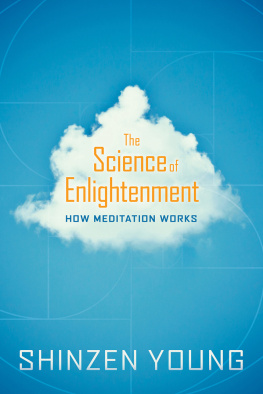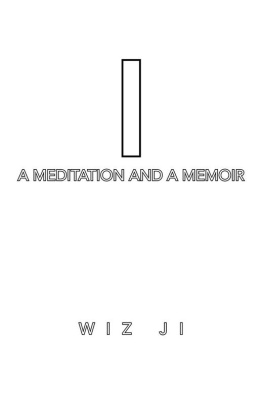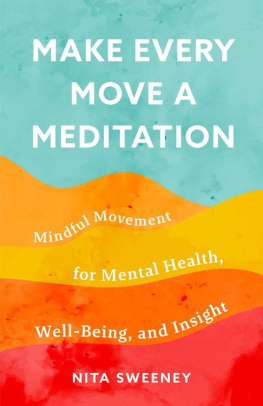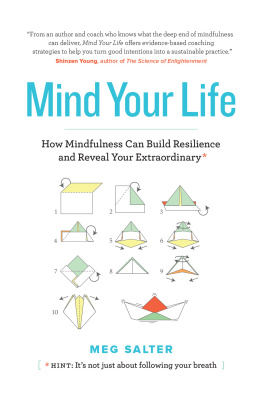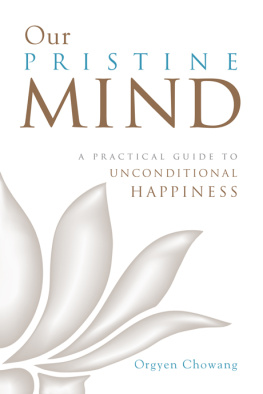
To my teachers
We shall not cease from exploration
And the end of all our exploring
Will be to arrive where we started
And know the place for the first time.
T. S. ELIOT, LITTLE GIDDING
Contents
Editors Foreword
I first encountered Shinzen Young while working as an editor at Sounds True almost twenty-five years ago. We put out a couple of audio programs with him, and as part of that, I helped create the tiny cassette-sized booklet that went with his Break Through Pain recording. That meant working with him quite a bit, going over the text, making edits, and so forth.
Sounds True was a dream job for me because of moments like this. Getting to see the world through the eyes of advanced practitioners, talking with them one-on-one about their understanding of their teachings and tradition, observing how they solved problems, and so on. I was a gung-ho spiritual seeker at the time, back from several trips to India, often paying good money to buy a book, hear a recording, or sit at the feet of a spiritual teacher. The fact that I was getting paid to work with them was almost too good to be true. It was like being a student at a real-life Hogwarts or going to meditation college. Given that meditation and spiritual practice was both my all-consuming personal interest as well as my job, I thought I had seen it all, so to speak. But Shinzen was something quite different.
This impression was confirmed a year or two later, when I was given the assignment of editing a much larger audio program by him. He had come into our new, spacious studio with five or six students who sat on the floor while he spent a solid week talking to and meditating with them. I had sat in on several of the recording sessions, and had been quite intrigued by what I heard. Tami Simon had asked Shinzen to deliver a brain dump of everything he knew about meditation, and it was fascinating. When the time came to edit this magnum opus, the computer hard drive contained almost fifty hours of his talks. (We edited digitally even though the program would be published on cassette.) My job then was to sit in a small, dark, very silent room and edit this enormous pile of material into a twelve-part cassette tape series to be entitled, The Science of Enlightenment. The process of editing reminded me of some of the retreat practices I had done.
The next couple of weeks were a revelation. Shinzens guidance, his concepts, his outlook were those of the kind of meditation teacher that I had sensed must be out there. He had a comprehensive grasp of Asian languagesthe original tongues of the books, scriptures, and terms that compose the bedrock of many of the meditative traditions. He had a scholars grasp of the philosophy of spiritual practice and was comfortable talking about not only the upsides of various viewpoints, but also their potential downsides in a frank and knowledgeable manner.
But he wasnt just some dry theoretician either. He had done extensive retreat practices in all three vehicles (i.e., types) of Buddhism, including three years as a robed Shingon monk in Japan and decades of hardcore traditional Zen retreats in both Asia and the United States. He had sat with vipassana teachers in India. And he had done numerous sweat lodges and sun dances with the Lakota Sioux in a fully traditional Native American context. He was even willingunlike so many American dharma teachersto talk about enlightenment as a serious goal of meditation practice, as something that a regular human being could aim for and achieve.
But there was more. Shinzen is a classic nerd, the kind of guy who wants to talk about arcane minutiae of word etymologies, and is highly conversant in science and math. A dharma talk with Shinzen is as likely to include a discussion of tensor calculus, the physics of fluid dynamics, or an unpacking of how the Japanese word Zen and the English word theory sprang from the same Indo-European root as it is to include an explication of meditation practice or aspects of the spiritual path. Whats more, he relates such topics to each other, interweaves them, and shows them to be interconnected facets of greater and deeper ideas and teachings.
On top of it all, Shinzen is a compelling storyteller. He has the most amazing tales, ranging from the often-shocking extremes of monastic practice in Asia to hilarious and insightful anecdotes about meditation centers in America.
In short, I was hooked. He was exactly the kind of teacher I had been looking for: brilliant, funny, learned, and steeped in a lifetime of serious practice. It took me about two weeks of heavy engagement to edit the tape series into its final form. The hardest part about it was the upper limit on the size of our tape sets, which meant that I had to leave so much valuable material on the (virtual) cutting room floor.
A decade later, I had left Sounds True, and that box of twelve audiocassettes had become something of a cult classic. Never a bestseller, it had legs as they say. The Science of Enlightenment was one of those rare programs about which listeners were likely to say, It changed my life. Particularly, long-time meditators who felt like their practice had become stale, or who had lost momentum, were benefitting from it. This unassuming program from a nerdy meditation teacher nobody had ever heard of had the secret sauce that could transform a solid but lackluster meditation practice into something truly alive, powerful, and life altering. Around that time, Tami approached me with a question: Would I be interested in editing the audio series into a book for Sounds True?
My answer was an instant and unequivocal Yes. We guessed it might take a few months to complete. (Can you hear the Fates giggling in the background?) Shinzen, Tami, and I were all excited about the possibilities of the book, and I got going right away.
Initially, the idea had been to simply make the tape set into a book, but I felt that here was a chance to rescue all that excellent material that I had had to cut out of the audio. So I obtained a transcription of the entire raw recording and worked from that. Making spoken word audio read well as text is not as easy as you might assume. There are a lot of differences between the spoken and written word, and sometimes things that make sense when said become ambiguous when the context, tone, and emphasis of the speaker are lost. Furthermore, the spontaneous wandering of live talks doesnt translate well into the linear logic we expect of books. Its an arduous process, but for me its also fun and fascinating. Within a few short months, just as we predicted, I had produced a rough draft of a large portion of the book.
It was a decent first shot, but there were several things I wasnt happy about. First, during the intervening years, I had spent many hours in meditation retreats with Shinzen, and I realized that while The Science of Enlightenment was a large and comprehensive program, it was actually missing a great deal of Shinzens vast storehouse of knowledge. I furthermore realized that Shinzens teachings had themselves evolved and been refined since the set was recorded. He is a very creative teacher, always refining and reworking his lessons. Thus, I felt compelled to supplement the original material by both adding to it and reworking it to fit his new formulations.
Little did I know the rabbit hole this would lead me down. Shinzen had a lot of other recordings, some of which I thought would be helpful to add in, and which I dutifully transcribed. I also interviewed Shinzen endlessly on the telephone, asking him clarifying questions on a multitude of topics. This produced many more hours of fascinating content, which also needed to be transcribed. Then there were the hundreds of hours of dharma talks. And as the years passed, dozens of hours of video also appeared. The project assumed a Sorcerers Apprentice quality; it seemed that the more questions I asked, the larger and deeper the scope of Shinzens answers became, and the bigger the task grew. There was always another facet, and another story, and another unexpected jewel.
Next page
